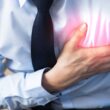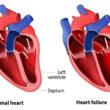Angina Pectoris
Angina Pectoris: How Reduced Heart Flow Explains Chest Pain
Angina pectoris, which is commonly known as just “angina,” is a symptom rather than an actual illness. It appears as discomfort or soreness in the chest that is brought on by a brief decrease in blood supply to the heart muscle. This decreased blood flow causes discomfort and may be an indicator of underlying heart issues since it is unable to supply the heart with enough oxygen-rich blood to meet its demands. This blog post explores the specifics of angina, elucidating its kinds, causes, symptoms, and available treatments to enable you to comprehend and properly manage this condition.
Table of Contents

The Lifeblood of the Heart: Blood Flow and Angina
- Heart Arteries: The oxygen-rich blood that the heart pumps out to itself is transported by these essential blood arteries. Unhindered blood flow is ensured by elastic, smooth coronary arteries.
- Build-Up of Plaque: These arteries can become narrowed by atherosclerosis, a condition in which fatty deposits known as plaque build up within them. Angina may develop if this constriction severely inhibits blood flow.
Angina Types: Recognising Their Distinctions
There are two primary forms of angina, each with unique traits:
- Angina stable: This is the most prevalent kind. Usually, mental stress or physical activity may cause the chest pain, which will go away with rest or treatment. These episodes can vary in frequency and severity.
- Unstable Angina: This kind is more serious. Unlike stable angina, the chest pain is erratic, can happen while at rest, and can be more intense or persistent. Unstable angina needs to be treated right away because it is a warning indication of a potentially fatal condition like a heart attack.
Recognising the Warning Sign: Angina Symptoms
Angina Pectoris
Angina’s most typical symptom is discomfort or soreness in the chest. But the precise features of this discomfort can differ:
- Location: Although it usually starts in the middle of the chest, the pain can also extend to the arms, shoulders, back, neck, or jaw.
- Description: People frequently describe the discomfort as searing, squeezing, pressing, or tight.
- Duration: Angina attacks usually pass after a few minutes and are usually relieved by rest or medicine.
- Complementary Symptoms: Breathlessness, queasiness, perspiration, or exhaustion are possible side effects of angina.
Finding the Offender: Reasons for Angina
Angina Pectoris
Coronary artery disease (CAD), or the narrowing of the coronary arteries as a result of plaque accumulation, is the main cause of angina. The following are some of the causes of angina and CAD:
- High cholesterol: LDL (“bad”) cholesterol levels are a primary contributing factor to high cholesterol.
- High Blood Pressure: Prolonged high blood pressure accelerates the formation of plaque by weakening and damaging the artery walls.
- Smoking: Smoking causes inflammation, thickens blood clots, and damages the artery lining, all of which are factors in angina.
- Diabetes: Angina can be brought on by diabetes, which can raise cholesterol levels and damage blood arteries.
- Family History: Your risk is increased if you have a close relative who has previously had heart disease.
- Unhealthy Diet: Consuming a lot of processed foods, added sugar, and saturated and trans fats can raise inflammation and aggravate cholesterol.
- Physical Inactivity: Insufficient exercise raises the risk of cardiovascular disease and raises harmful cholesterol levels.
Handling the Pain: Alternative Angina Treatments
Angina Pectoris
Relieving symptoms, halting more coronary artery constriction, and lowering the risk of a heart attack are the objectives of angina treatment. Possible course of treatment options include:
- Modifications to lifestyle: These are frequently the mainstay of therapy. These consist of giving up smoking, controlling weight, exercising frequently, and implementing a heart-healthy diet.
- Medication: A number of drugs, such as cholesterol-lowering drugs, blood vessel-relaxing drugs (nitroglycerin), and blood flow-improving drugs (beta-blockers), can be helpful.
- Procedures: To open blocked or narrowed arteries, minimally invasive techniques like coronary artery bypass surgery or angioplasty and stenting may be required in some circumstances.
Taking Care of Your Heart: Avoiding Angina and Its Complications
Angina Pectoris
Living a heart-healthy lifestyle can help you lower your risk of angina and its aftereffects:
- Healthy Diet: A healthy diet should be limited in processed foods, added sugar, and saturated and trans fats. Give ample attention to whole grains, fruits, veggies, and lean protein sources.
- Regular activity: Try to get in at least 150 minutes a week of moderate-to-intense activity or 75 minutes a week of vigorous exercise. Any kind of exercise is preferable to none at all.
- Weight control: Keeping your weight within a healthy range eases the strain on your heart and blood vessels.
- Giving up smoking: One of the most beneficial things you can do is to stop smoking.


